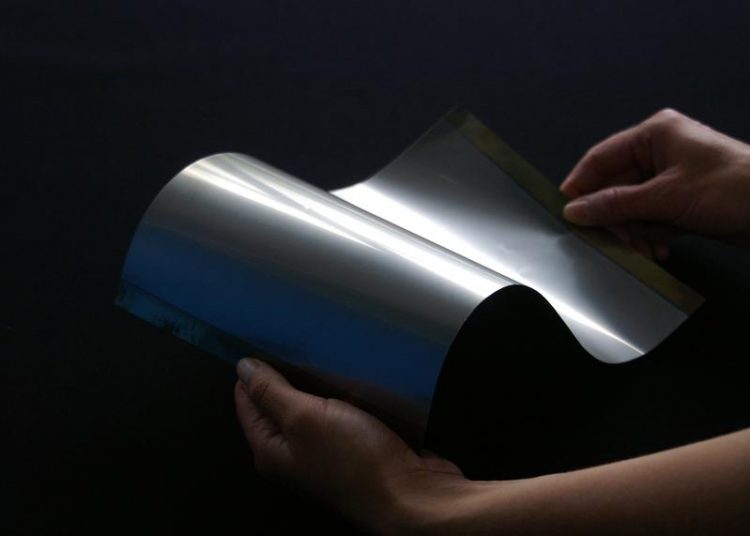Hannover Messe: Glass-like diffusion barrier for flexible CIGS solar cells for spraying

Glass-like diffusion barrier for flexible CIGS solar cells for spraying. Copyright: INM
From 7 to 11 April 2014, the researchers of the INM will be presenting this and further results in Hall 2 at the stand C48 of the Hannover Messe in the context of the leading trade fair for R & D and Technology Transfer. This includes new developments for corrosion protection coating and low-friction coating as well as antimicrobial coatings and printed electronics.
The glass-like layer increases the efficiency of the solar cells in a different way. “It acts as an iron diffusion barrier, preventing the unwanted penetration of iron ions into the absorber layer. Exactly that would lead to the loss of the efficiency”, explains Peter William de Oliveira, Head of the Optical Materials Program Division.
“At the same time, the barrier works as an insulating layer and reduces unwanted electrical currents from the absorber to the substrate”, he adds. In addition, the coating is a source for the doping element sodium which increases the efficiency of flexible, metal-based CIGS thin-film solar cells to 13%. The new barrier layer also makes it possible to monolithically connect several cells on one and the same substrate to modules.
The glass-like diffusion barrier is applied to the metal substrate using the sol-gel process. It is transparent, flexible and only two to five micrometers thick. Flexible A3-size films can be produced by dip coating and slot coating.
For the further upscaling process, researchers at the INM then developed a method with which they can apply the coating via a spray process to large substrates with a variety of shapes. In addition, films up to 50 meters long and 1.5 meters wide can also be coated using classic roll-to-roll processes.
Contact:
Dr. Peter William de Oliveira
INM – Leibniz Institute for New Materials
Head Optical Materials
Phone: +49681-9300-148
peter.oliveira@inm-gmbh.de
Your contact at the stand:
Dr. Thomas Müller
Dr. Michael Opsölder
The INM will also present its competence within various talks in Hall 2 at the Tech transfer stand.
* „Nanotechnology at the INM – Leibniz Institute for New Materials“, Dr. Mario Quilitz, Monday, 7.4. 2014, 10:15 – 10:30 a.m.
* „Nanotechnology in the Leibniz Network Nano“, Dr. Mario Quilitz, Monday, 7.4.2014, 12:00 – 12:15 p.m.
* „Nanoparticles for Optics and Electronics“, Dr. Peter William de Oliveira, Tuesday, 8.4.2014, 11:00 – 11:10 a.m.
* „Nanomers – Highly structured integrated functional coatings for practical solutions in industrial applications“, Dr. Carsten Becker-Willinger, Tuesday, 8.4.2014, 11:20 – 11:35 a.m.
INM conducts research and development to create new materials – for today, tomorrow and beyond. Chemists, physicists, biologists, materials scientists and engineers team up to focus on these essential questions: Which material properties are new, how can they be investigated and how can they be tailored for industrial applications in the future? Four research thrusts determine the current developments at INM: New materials for energy application, new concepts for medical surfaces, new surface materials for tribological applications and nano safety and nano bio. Research at INM is performed in three fields: Nanocomposite Technology, Interface Materials, and Bio Interfaces.
INM – Leibniz Institute for New Materials, situated in Saarbruecken, is an internationally leading centre for materials research. It is an institute of the Leibniz Association and has about 195 employees.
Media Contact
All latest news from the category: HANNOVER MESSE
Newest articles

First-of-its-kind study uses remote sensing to monitor plastic debris in rivers and lakes
Remote sensing creates a cost-effective solution to monitoring plastic pollution. A first-of-its-kind study from researchers at the University of Minnesota Twin Cities shows how remote sensing can help monitor and…

Laser-based artificial neuron mimics nerve cell functions at lightning speed
With a processing speed a billion times faster than nature, chip-based laser neuron could help advance AI tasks such as pattern recognition and sequence prediction. Researchers have developed a laser-based…

Optimising the processing of plastic waste
Just one look in the yellow bin reveals a colourful jumble of different types of plastic. However, the purer and more uniform plastic waste is, the easier it is to…



